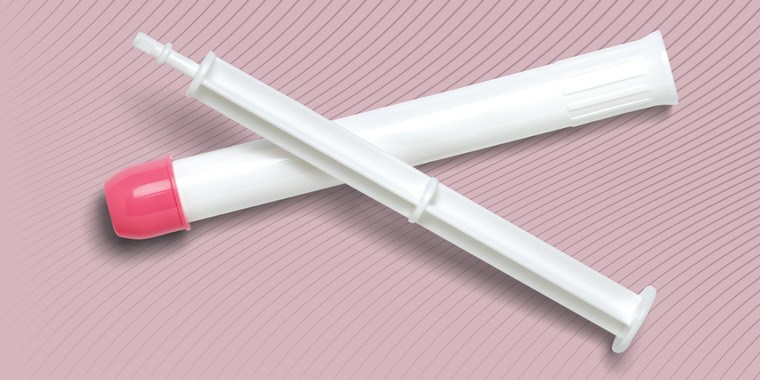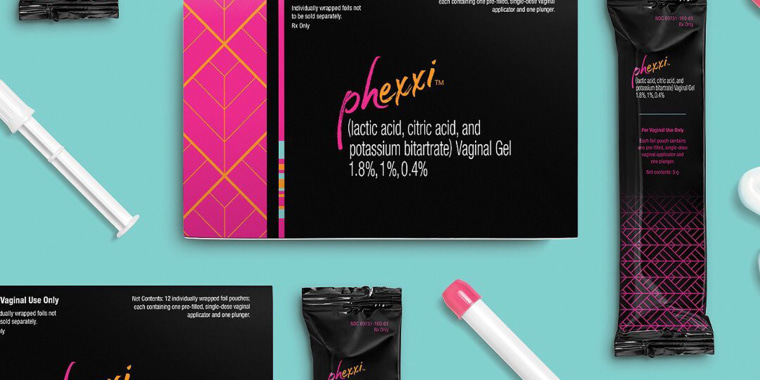For years, women seeking non-hormonal birth control options haven't had that many to choose from.
Enter Phexxi, a contraceptive gel free of hormones, which the Food and Drug Administration approved in May 2020. The product from Evofem Biosciences Inc. became available to consumers last fall.
"The non-hormonal aspect of this product is really exciting," Dr. Kelly Culwell, chief medical officer at Evofem, told TODAY last year. "There are a fair number of women who cannot use hormones at all for medical reasons, but there are a lot of women who are just concerned about hormones."
How does Phexxi work?
Usually, when sperm enters the vagina, it raises the vagina's pH level, which allows the sperm to work its way up the reproductive canal. Phexxi, however, keeps vaginal pH in a normal range, between 3.5 and 4.5, which immobilizes and kills the sperm, according to Culwell.
"It (harnesses) the body’s own natural, vaginal environment to act as a contraceptive method," she explained.

The product, which requires a prescription, comes in a pre-filled applicator similar to a tampon, which the woman inserts into her vagina. It must be used before every act of intercourse, ideally somewhere between an hour and "immediately before" sex, Culwell said.
She added that Phexxi is "highly viscous," so it doesn't leak during sex, and it leaves the body with the sperm and other vaginal fluids.
Phexxi does not protect against sexually transmitted diseases or infections.
How is Phexxi different from existing options?
Dr. Shefali Pathy, an OB-GYN and professor at Yale School of Medicine in New Haven, Connecticut, who's not affiliated with Evofem, called Phexxi a "novel" type of spermicide.
Most spermicides, which come in films, foams and more, rely on a chemical, nonoxynol-9, which kills sperm by destroying their cellular membranes. Culwell expained that nonoxynol-9 can be dangerous for women with increased risk of HIV and other sexually transmitted infections because it can also "destroy the cell membranes of the vaginal wall."
"A lot of health care providers steer women away from products containing nonoxynol-9," Culwell said.
Phexxi, she stressed, contains only "naturally occurring" ingredients that are "generally recognized as safe by the FDA." These include lactic acid, citric acid and potassium bitartrate.
Culwell also highlighted that Phexxi is "on-demand," meaning you only use it when you need it, and doesn't require a partner's participation.
How effective is Phexxi?
The American College of Obstetricians and Gynecologists declined to comment on Phexxi last year because it had yet to conduct "significant clinical review of peer-reviewed evidence," a spokesperson told TODAY.
Based on clinical trials, Culwell estimated that with typical use, Phexxi works 86.3% of the time, about the same as condoms. This percentage includes women who used it too early or occasionally forgot altogether. With ideal use, it's 93% effective, she said, adding that it can be used with condoms or diaphragms to boost its effectiveness.
Last year, Pathy told TODAY that she found Phexxi's typical-use effectiveness "concerning. (For) approximately 15 women out of 100, it’s going to fail." In contrast, IUDs, which can be hormone-free, don't have the same "broad" range of effectiveness between ideal and typical use, she said.
For comparison, here are the typical-use effectiveness rates for other common contraceptive methods, per the Centers for Disease Control and Prevention:
- Hormone-free, copper IUD: 99.2%
- Hormonal IUDs: 99.6-99.9%
- Hormonal implant: 99.9%
- Birth control pill (with hormones): 93%
- Diaphragm: 83%
- Male condoms: 87%
- Female condoms: 79%
- Spermicides: 79%
What are the risks of Phexxi?
Per the FDA, the most common adverse reactions to Phexxi occurred in greater than or equal to 2% of users. Common side effects include:
- Vulvovaginal burning, itching, pain or discomfort
- Vulvovaginal mycotic (a type of fungus) infection
- Genital discomfort
- Bacterial vaginosis
- Vaginal discharge
- Urinary tract infections
- Discomfort while peeing
Another concern of Pathy's: It may be hard for women to "monitor" whether they're using Phexxi correctly.
"If you're using it as instructed, how do you know it's not going to be different for you versus someone else because you haven't reached the (necessary) pH level?" she said.
With a condom, for example, you know if you use one and if it breaks. If users can check vaginal pH levels after administering Phexxi, that could overcome the "margin of error," Pathy added.
In response, Evofem explained "our studies show that regardless of the 'starting' vaginal pH levels (prior to the introduction of semen), Phexxi’s acid buffering qualities will help ensure a healthy vaginal pH range of 3.5-4.5 — even in the presence of semen."
Who should use Phexxi?
The FDA discourages women with recurrent UTIs or a history of urinary tract abnormalities from using Phexxi.
According to Culwell, there's no specific demographic of women that Phexxi's best suited for. She said it's a good option for any woman looking for non-hormonal contraception, "either because she’s tried hormones in that past and hasn’t liked them ... or they have side effects she’s not happy with."
Culwell also stressed that Phexxi users must be willing to apply the product before every act of intercourse. For women seeking a "set it and forget it" option, like an IUD, this isn't the best choice. Phexxi is sold in a box of 12 single-dose applicators, and the price will depend on an individual's insurance coverage.
According to Pathy, this product is ideal for women in monogamous relationships who don't want to use hormonal, long-acting or permanent birth control — and who understand how to use it correctly.
CORRECTION (July 3, 2020, 10:52 a.m.): An earlier version of this article misstated that adverse reactions to Phexxi occurred in less than 2% of users. Adverse reactions occurred in greater than or equal 2% of users.
